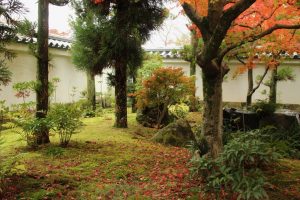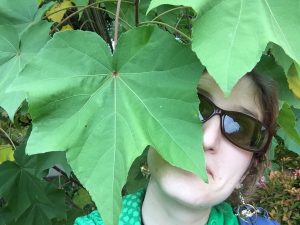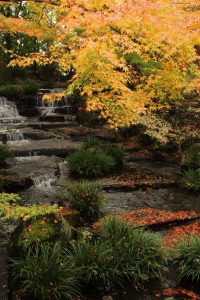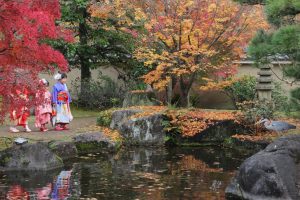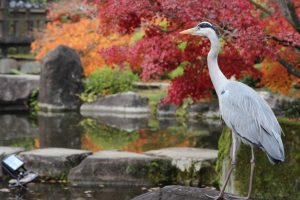
Himeji castle!
Today was our last time on the shinkansen for this trip, and naturally it would be the time I screwed up our tickets. I was feeling confident I understood the sometimes ambiguous train ticket windows a few days ago, and hadn’t paused to wonder why the fare had been so cheapish upon purchase.
Our ticket was rejected in the gate – I had forgotten to purchase a zone fare ticket. Drat. At least we were early, and a helpful man sorted out our tickets after we paid him some money.
Himeji is an hour from Hiroshima, and half an hour from Osaka (our next destination). Generally, when you see a picture of a castle in Japan, it’s either Himeji or Osaka Castle. Himeji is also known as White Heron castle, for its beautiful white roof tiles and white walls. It sits atop a hill, as any good castle does, towering over the teeny town of Himeji.
The last time I was here, it was 2007 and the gods of Himeji spurned me. The castle was closed for its yearly cleaning at the time. Not today, travel satan, not today. I had looked this shit up and the castle was definitely open. We stashed our bags at the station (there were loads people who used the coin lockers but didn’t lock their stuff?!) and wandered up the road to the castle purse first.
Whether you’re standing at a distance or up close, the castle is imposing and magnificent.



Sometimes, I think about how places I see on vacation are older than the States. Himeji falls into this category: construction on the castle began about 600 years ago, and it’s been rebuilt and restored a few times since. Each lord of the castle added to the defenses and perimeter, making it more and more impressive with each iteration.
It had lots of places to store your weapons, places to hide your warriors, places to chuck rocks down at intruders, and horrifically steep stairs inside that would probably slay intruders if they survived all of the rocks, spears, and warriors on the way to the castle. The stairs even had the Japanese people with ducking down to fit up the deadly steps.
The entire castle had a pleasant wood fragrance and offered beautiful views of the surrounding area. You could certainly see an enemy horde coming to kill you from the sixth floor with ease!




In the mid-1900s, careful presentation work on the castle began. Damage was so extensive they had to deconstruct the castle and meticulously study and re-build it from the foundation up. A second restoration was done from 2009, finishing in 2015. I guess I feel slightly vindicated about not seeing it in 2007 – we were seeing freshly redone Himeji today.

Before leaving, we went to koko-en, gardens nestled just west of the castle. If we were smart, we would have purchased our tickets with our entrance to Himeji, but we are impulsive creatures who lack planning powers occasionally, so we ponied up 300 yen for entrance to the gardens. Totally worth it.
Koko-en is built around nine reconstructed samurai homes. The gardens are immaculate (mostly – someone was slacking on their fall leaf pick-up duties) and feature many waterfalls and trickling streams, crossed by large stones you could hop across. There were trees with leaves as big as my face, ferns, and brilliant red maple trees. Little girls in kimono posed for pictures for their parents, throwing up leaves charmingly as parents snapped away with DSLR cameras.
From Himeji, it was a quick hop to Osaka on the bullet train. Osaka is a new place for me, known for commerce and dialects. I was mostly worried it would be like landing on the moon, but it wasn’t – I could still understand most of the words. Yay.
We didn’t get lost in the station, but it was under heavy construction and non-Japanese speakers might have been more than a little perplexed. We made it to what I thought was our station but wasn’t: it was a nearby station with a same name on another train line. It was only ten minutes extra to our ABB, so we rolled our suitcases noisily through the streets of Osaka.
If you would like a continuation of the Japanese Laundry saga (which I know you do, dear reader), I putzed around with this washer and dryer. It too had a “dry” mode, and I also discovered there was an actual dryer setting. Eager to have some more dry shirts, I plopped in the shirts and tried all of these settings. This is what the dry setting looks like:
If you looked at this picture and said to yourself, “Why, that machine looks like it is indeed full of water!” you would be correct. That is water. On the dry setting. I don’t understand. I recall my host parents washing machine being much easier to use than these. After two failed attempts at getting the laundry to dry in the machine, I gave up and dried my way the only Japanese way I knew how: on the line on the balcony.
Laundry woes aside, we had planned to go out, but a tendon in my foot was starting to hurt and my traveling companion’s feet were also in rebellion, so we ended up staying in and watching Japanese TV for the evening like giant potatoes.
I learned science stuff, watched a detective show inspired by Sherlock, and watched a betting race game where they made celebrity contestants bet on various events, like a beach race between a runner, a BMX cyclist, and horse and a dog (the jockey missed the flag at the end and the dog ended up beating the running man to win it all); a weird triathlon of sorts involving running up a ski slope and singing karaoke, and a competition to see who could shoot a little doll farthest (an archer, fireworks, giant catapult, or a pitching machine – the winner was the fireworks).
They also brought back a reference to a comedy skit that was popular when I lived here, which was kind of shocking because it meant I knew a cultural thing. The delightful skit is below:
Tomorrow, we will do actual Osaka exploring.
